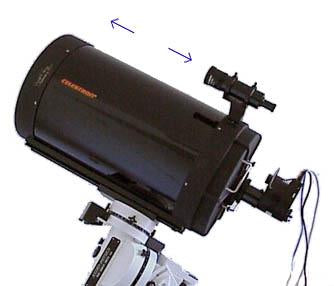
Balancing a German Equatorial Mount
Achieving Balance
First, we will look at how to balance a telescope, then discuss the ideas behind balance so you can better understand it.
Balancing a German-Equatorial-Mounted Telescope
It is very important to balance the telescope tube (declination axis) first! The most common balancing error is to reverse these steps. See the section at the bottom of this page for details why this procedure is critical.
1) Begin by rotating the telescope and counterweight bar so both are parallel to the ground, as shown below. Carefully release the clutch holding the optical tube (declination) axis in place and see if the telescope is front-heavy or rear-heavy.

Above: Push the telescope gently up and down to determine if it is front- or back-heavy
2) Rotate the telescope so that it is directly above the mount and aimed north. The telescope can now be slid forward or backward to achieve proper balance.

Above: If the telescope is front-heavy slide the tube rearward on the mount. If the scope is rear-heavy, slide the tube forward on the mount.
3) Bring the telescope and counterweight bar back over into the horizontal position. Carefully release the clutch holding the counterweight bar (right ascension) axis and see if the setup is telescope- or counterweight-heavy.

Above: Return the telescope to the horizontal position once balanced in declination. If the telescope is heavy toward the optical tube, slide the counterweight down the shaft away from the scope. If the telescope is heavy toward the counterweight, slide the weight up the shaft toward the scope.
Balancing Theory
Why do you have to balance a German equatorial mount's optical tube first? The reason lies in the position of the center of gravity. If you do not balance the optical tube first, the center of mass of the tube is offset, meaning the position of the counterweights on the shaft will be incorrect. Even if the telescope seems balanced in one position, when pointed to another area of the sky it may not be balanced.
If the telescope tube is not balanced first, then the center of gravity (CG) of the system is not along the counterweight shaft axis. This will cause the counterweight to be placed too close to the telescope.

Balancing the optical tube first places the center of gravity in the correct position. Now the counterweight will be in the right place when the telescope is balanced in right ascension and the entire system has been properly dynamically balanced.


